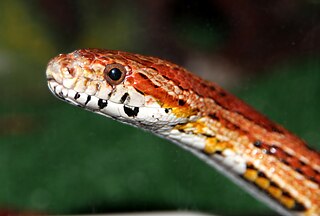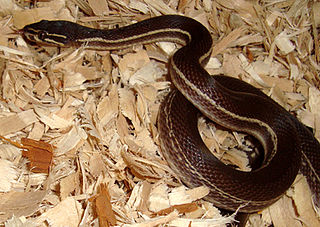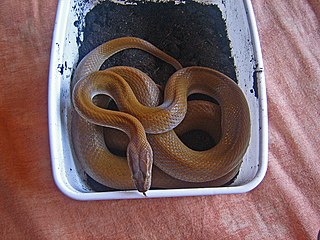
The Leptotyphlopidae are a family of snakes found in North America, South America, Africa and Asia. All are fossorial and adapted to burrowing, feeding on ants and termites. Two subfamilies are recognized.

The Cylindrophiidae are a monotypic family of secretive, semifossorial, non-venomous snakes containing the genus Cylindrophis found in southeastern Asia. These are burrowing snakes and most have a banded pattern on the belly. Currently, 14 species are recognized, all with no subspecies. Common names include Asian pipesnakes and Asian cylinder snakes.

Pantherophis is a genus of nonvenomous colubrid snakes endemic to central and eastern regions of North America. It consists of the North American ratsnakes, the foxsnakes, and the cornsnakes. The genus, which contains 10 recognized species, first appeared in the fossil record in the Middle Miocene around 16.3 million years ago. They are a large terrestrial snake genus that lack subocular scales. Originally classified in the genus Elaphe, phylogenetic studies have found this taxon to be closely related to Pituophis. As with all snakes Pantherophis is an obligate faunivore with a diet that consists of small mammals, birds, reptiles and amphibians, and even insects. While many species conservation status is categorized as "least concern", many local populations in some species have declined where some places have them listed as federally protected. The corn snake is a popular pet reptile, due to the availability of captive-bred animals, their low maintenance and calm disposition, and the variety of color morphs. There are other species of Pantherophis that are in the pet trade, though are not as popular as the corn snake.

Lamprophis is a genus of medium-sized, nonvenomous snakes commonly referred to as African house snakes, in the family Lamprophiidae.

Cerastes is a genus of small, venomous vipers found in the deserts and semi-deserts of northern North Africa eastward through Arabia and Iran. Three species are currently recognized by ITIS, and an additional recently described species is recognized by the Reptile Database. Common names for members the genus include horned vipers, North African desert vipers, and cerastes vipers.

The Natricinae are a subfamily of colubroid snakes, sometimes referred to as a family (Natricidae). The subfamily comprises 36 genera. Members include many very common snake species, such as the European grass snakes, and the North American water snakes and garter snakes. Some Old World members of the subfamily are known as keelbacks, because their dorsal scales exhibit strong keeling.
Gonionotophis is a genus of snakes, known commonly as African ground snakes and file snakes, in the family Lamprophiidae. The genus is endemic to Central Africa.
Hormonotus is a genus of snakes. At present, this genus is monotypic, as there is only one commonly accepted species in it, Hormonotus modestus, commonly known as the Uganda house snake or yellow forest snake. It is widespread in tropical Africa. Its sister taxon is Inyoka swazicus, the Swazi rock snake.

The Colubrinae are a subfamily of snakes within the family Colubridae. It includes numerous genera, and although taxonomic sources often disagree on the exact number, the Reptile Database lists 717 species in 92 genera as of September 2019. It is the second largest subfamily of colubrids, after Dipsadinae. Many of the most commonly known snakes are members of this subfamily, including rat snakes, king snakes, milk snakes, vine snakes, and indigo snakes.

The Alethinophidia are an infraorder of snakes that includes all snakes other than blind snakes and thread snakes. Snakes have long been grouped into families within Alethinophidia based on their morphology, especially that of their teeth. More modern phylogenetic hypotheses using genetic data support the recognition of 19 extant families, although the taxonomy of alethinophidian snakes has long been debated, and ultimately the decision whether to assign a particular clade to a particular Linnaean rank is arbitrary.

Lycodonomorphus is a genus of snakes commonly referred to as African water snakes. They are small, nonvenomous snakes, with all members being endemic to Africa, especially Tanzania.

The Cape file snake is a species of large, non-venomous snake endemic to Africa, belonging to the family Lamprophiidae.

Boaedon is a genus of African lamprophiids consisting of the "brown" house snakes. The genus was originally described by Duméril but the species contained were reclassified as Lamprophis by Fitzinger in 1843, this taxonomy remained widely accepted until November 2010 when a phylogenetic study was published by C.M.R Kelly et al. who resurrected the Boaedon clade. Although commonly regarded as belonging to the Colubridae, primary literature usually lists them and related species as belonging to the family Lamprophiidae within the superfamily Elapoidea, which includes the venomous cobras and mambas.
Inyoka is a monotypic genus of southern African snakes. The word "inyoka" means "snake" in Zulu, Xhosa, Swahili, Shona and other African languages. These snakes were previously grouped in the genus Lamprophis but were found to be closer related to Hormonotus; a substantial genetic divergence between them and a 1900 km gap between their geographic ranges meant a new genus was erected for Lamprophis swazicus, the sole species of the new genus.

Boaedon lineatus, the striped house snake, is a species of lamprophiid from throughout Africa. This species has a wide range stretching from Tanzania through Central Africa as far as Uganda. They are kept as pets with increasing regularity, often captured and exported for the pet trade. Until November 2010, this species was grouped in the genus Lamprophis, but a paper published by Kelly et al. reclassified this species in the genus Boaedon.

Boaedon capensis, the Cape house snake, also known as the brown house snake, is a species of lamprophiid from Botswana, South Africa, Mozambique, Zambia and Zimbabwe. They are a non-venomous lamprophiid. This species was previously grouped in the genus Lamprophis but is regrouped with the genus Boaedon.

The Lamprophiidae are a family of snakes found throughout much of Africa, including Seychelles. There are 89 species as of July 2022.

Lamprophiinae is a subfamily of lamprophiid snakes, a large group of mostly African snakes, most of which were formerly classified as colubrids but which we now know are actually more closely related to elapids.

Lycodonomorphus inornatus, commonly known as the olive house snake, the black house snake, and the olive ground snake, is a species of nonvenomous snake in the family Lamprophiidae. The species is endemic to southern Africa. It is a nocturnal snake with terrestrial habits.

The black file snake, also known commonly as the dwarf file snake or the Nyassa file snake, is a species of snake in the subfamily Lamprophiinae of the family Lamprophiidae. The species is endemic to Africa.














